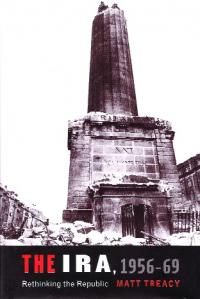The IRA, 1956–69: rethinking the Republic
Published in 20th-century / Contemporary History, Book Reviews, General, Issue 5 (Sept/Oct 2011), Reviews, Volume 19
The IRA, 1956–69: rethinking the Republic
Matt Treacy
(Manchester University Press, €75.60)
ISBN 9780719084720
The historiography of Irish republicanism has greatly improved in recent years thanks to authors such as Brian Hanley, Richard English and Martyn Frampton. This book, Matt Treacy’s first, adds significantly to this growing body of work, charting the internal debates and developments within the IRA and Sinn Féin from the collapse of the ill-fated border campaign to the infamous split in 1969. It is based on the latest available archival material from Irish and British sources, combined with an intimate knowledge of the dynamics of 1960s republicanism. As a result, Treacy has produced a dispassionate narrative that may yet become the final word in a number of controversies.The opening chapter on the fallout from Operation Harvest (the 1956–62 border campaign) breaks little new ground, but each of the book’s six subsequent chapters adds significantly to our understanding of their subjects. The ideology of ‘traditional’ republicanism is detailed in Chapter 2. The confusing and often contradictory influence of diverse sources from James Connolly to Pope Leo XIII is deftly traced. So too is the challenge posed to the traditionalists from the modernisers. Treacy’s main contention is that neither the traditionalists nor the modernisers had much resonance with Irish society, and this more than any other issue was the reason for republicanism’s irrelevance to the mainstream of social or political life.While the author adopts the commonly used labels of traditionalist and moderniser, his meaning is more nuanced than that of earlier writers. Crucially Treacy warns against the idea that this was a simple left–right division. The modernisers clearly embraced a particular variant of Marxism, albeit mediated via the intellectual lens of C. Desmond Greaves. The traditionalists also provided a coherent alternative to the status quo, based on Catholic social teaching, a commitment to social justice and the rights of workers, and a focus on protecting indigenous business. Set against this backdrop, the subsequent chapters on republican electoral and political strategy are more measured and more balanced than earlier writings on the same topics. The abstentionist debate is rehearsed in Chapter 3. Treacy lays much of the blame for the marginality of republicanism during this period on the pro-abstentionist position. Nevertheless, he is equally critical of the idea that the modernising project constituted any form of threat to the status quo. The book comes into its own in the chapters on the Wolfe Tone Society and on 1966, the 50th anniversary of the 1916 Rising. Treacy deals with each of the key themes in these chapters with a calm reflection, focusing on the available facts. In each case the claims of the key protagonists are defused. Did the Communist Party of Great Britain and the Connolly Association deliberately attempt to influence Irish republicanism during this period? Clearly they did, but their ability to do so was a result of the weaknesses inherent in 1960s republicanism itself and produced far less than claimed.On the issue of the level of threat posed by the IRA in 1966, Treacy contrasts the security assessments of the Irish and British governments to the exaggerated claims made at the time by the RUC. His conclusion is that the IRA neither posed nor was capable of posing a threat to the stability of the northern or southern states. The book concludes with an account of the impact of the Northern crisis on the emerging divisions within the IRA and Sinn Féin. The most significant section of this chapter deals with the role of Fianna Fáil in the 1969 split. Treacy provides a pretty definitive sequence of events challenging the argument that Fianna Fáil deliberately set about provoking a split in the republican movement. The author also provides new information on minor aspects of the 1960s republican narrative, such as the activity of the Cork-based An Phoblacht group centred around figures such as Jim Lane. This self-consciously left-republican collection of activists sat uneasily between both the traditionalists and the modernisers, embracing the new drive for agitational politics of the Goulding faction while remaining committed to the utility of armed struggle as argued by the traditionalists. Treacy’s main conclusion is that, despite the intensity and at times bitterness of the internal arguments and divisions of 1960s republicanism, the two key protagonists—traditionalists and modernisers—achieved little for their efforts. The inheritors of these two positions, namely Republican Sinn Féin and the Workers’ Party, today languish at the margins of Irish political life, much as they did in the 1960s. Nevertheless, Treacy also challenges the failure of many historians of Irish republicanism to appreciate the fluid and contingent nature of republicanism throughout its history. In place of an earlier moralising discourse unable to see the shifting and contested nature of republicanism, Treacy provides an account that charts the continuities and discontinuities in equal measure, which in turn provides a more complete picture.The IRA, 1956–69: rethinking the Republic is a valuable book. It provides a more reasoned, factual and dispassionate account of an important period in Irish republican history. It does so through a close reading of the available empirical evidence and an empathy with its subject-matter. As a result, it is an example of political history at its best—honest, rigorous and human. HI
Eoin Ó Broin is a writer, political activist and Sinn Féin Árd Comhairle member.
















